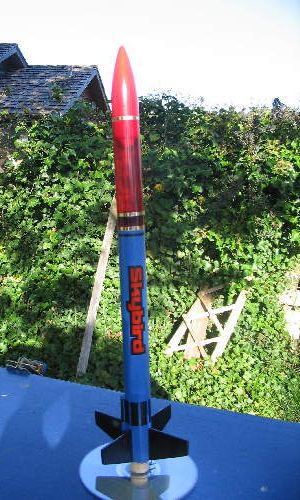| Construction Rating: | starstarstarstar_borderstar_border |
| Flight Rating: | starstarstarstarstar_border |
| Overall Rating: | starstarstarstar_borderstar_border |
| Diameter: | 0.98 inches |
| Length: | 15.50 inches |
| Manufacturer: | Custom Rockets  |
| Skill Level: | 1 |
| Style: | Sport |
Brief:
The Custom Rocket Sky Bird is a 4 fin payloader rocket. My kit was a gift from
a Secret Santa via the 2005 gift exchange at The Rocketry Forum. This is a
skill level 1 kit.

Construction:
The kit includes:
- BT-50 body tube, 9 inches,
- BT-50 Plastic Nose cone
- Red tint plastic payload section, 3.875 inches
- Plastic coupler bulkhead
- Screw eye
- BT-20 (18mm) motor mount with two 20-50 centering rings, motor hook, and thrust ring
- Elastic shock cord
- Die cut fins
- 1/8" launch lug
- Waterslide decals
- 12-inch plastic parachute kit with shroud line tabs (unassembled)
- Instructions with cut out for a tri-fold recovery mount
The instructions are clear and easy to follow. They go into good detail in finishing the rocket according to the cover art and include launch instructions. Putting the kit together was straightforward and easy to do. The balsa fins were easy to remove from the die-cut material as they are from good and solid stock. In previous Custom kits I've had problems with fitting centering rings and the thrust ring which were too tight but there were no problems like that with this kit. All the pieces fit together well with the exception of the plastic coupler which needed light sanding to get it to fit into the payload bay. The payload was glued to the plastic coupler with Testors model cement. The coupler to body tube attachment is a little loose as is the nose cone, but both of these problems are easy to fix by adding a little masking tape to the shoulders for a better fit. The instructions missed this detail. I used yellow carpenter's glue for fin and motor tube assembly.
I made a small modification to my kit. I added a 20-inch piece of 220-pound test Kevlar to the recovery system and a Teflon tape pompom for reusable recovery wadding. The kit included a very short piece of elastic cord, which was to be attached via a tri-fold paper mount. As with many kits, the included elastic is too short and I make this modification to most of my kits now. The additional weight from this is less than 2 grams. Prior to gluing in the assembled motor mount, I tied the Kevlar line around the motor tube and over the forward centering ring. The Kevlar line extends through the body tube and will hang about 6 inches past the tube. I put a loop in the end to attach the included elastic recovery line and pompom. The other end of the supplied elastic was tied to the screw eye, which was just screwed, into the hole on the bulkhead/coupler. The parachute is attached to a loop near the coupler instead of attaching the parachute to the eye hook as the instructions suggest. I've had better recovery doing this on other rockets.
Finishing:
The body tube is very good quality for finishing. I sanded lightly with 220
grit sandpaper. There are no lines on the tube to be filled. The fins were
filled with thinned lightweight filler and then given a coat of sanding sealer.
The airframe and nose cone were primed with my favorite sandable primer and
then painted in the finishing colors. I chose colors different from the
packaging art. The decals were put on as they were intended and I had no
trouble with that and I am very glad to see good quality waterslide decals.
They are always so much better to see on a finished kit than the self-sticking
type in other off the shelf kits. I also added some "Bling" with 3
strips of gold foil 0.125 inch wide pinstriping.
Construction Rating: 3 out of 5
Flight:
The final weight of the rocket comes in at 38 grams (1.36 oz). The weight given
on the kit package was 30.37g (1.07 oz). My measured center of gravity is 22.8
cm past the nose cone tip. I constructed the rocket in RockSim, which showed
good stability margins and launch speeds with all suggested motors and up to
22g of payload in the payload compartment.
I launched the Sky Bird in light winds without a payload and used a 30-inch rod. On a B4-4 the rocket had good speed and a great altitude for a small field. No windcock was noticed. I had cut a 2 inch spill hole in the stock parachute and the rocket recovered nicely about 60 feet down wind from the pad. I used a Teflon "pompom" for ejection wadding. I didn't have time to try any other motors but I expect a B6-4 to have a very similar flight. A C6-5 will really put this one up there and I will try that on a larger field.
Recovery:
The Sky Bird flies well and recovers nicely. The shock cord is way too short. I
highly recommend to other builders that they add something to lengthen the
recovery system.
Flight Rating: 4 out of 5
Summary:
Having built 3 other Custom Rocket kits in the past I was happy to find that
the parts all fit well which had been a problem in their other kits. The design
is simple and does make for a good first rocket as a Level 1 kit should be. The
tinted payload is a nice feature. The tint looks so much better that most
payloaders with clear tubes.
The only problem or CON worth mention is the short recovery cord and attachment method. The design works for a while but it is outdated.
Overall Rating: 3 out of 5
 |
 |
Flights
Sponsored Ads
 |
 |











